Bihu Festival
Bihu is the essence of Assam and is celebrated across the state with a tremendous zeal and enthusiasm. There are three Bihu festivals namely ‘Bohag Bihu’ celebrated in the month of ‘Bohag’ (Baisakh, the middle of April), ‘Magh Bihu’ celebrated in the month of ‘Magh’ (the middle of January), and ‘Kati Bihu’ celebrated in the month of ‘Kati’ (Kartik, the middle of October). Each of the Bihu festival has its own significance and is celebrated with its own traditions.
The Bohag Bihu, also called the Rongali Bihu is a festival of merriment and heralds the Assamese New Year and the onset of spring. The first day of the Bohag Bihu is called Goru Bihu. Bulls and cows are bathed with turmeric, fed with gourds and brinjals and provided with new attaching ropes. The second day of the Rongali Bihu festival (the first day of the Assamese New Year) is called the Manuh Bihu. Men, women and children put on new clothes, special dishes are prepared at every home for feasts, Pitha’s of various kinds are the pre requites. It is a day of merriment and festivity. People visit their friends and relatives with food items and gifts. The close relatives and friends are also gifted with hand-woven scarves called ‘Gamucha’ as an honorary felicitation.

A glimpse of the traditional Bihu Dance with the dancers dressed in traditional attire
The Magh Bihu is also called Bhogali Bihu, which is quintessentially the festival of food. The Magh Bihu marks the end of the harvesting season. The eve of the Magh Bihu is called the Uruka. It is the most gastronomical night of the year in Assam when family and friends get together and feasts around a bon fire. The next day is the main Magh Bihu. In the early morning, people take bath and burn the main ‘Meji’ built with bamboo and wood. People gather around the ‘Meji’ and pray to the Holy Fire by offering ‘Maah Khorai’ and ‘Pithas. The traditional breakfast ‘Jalpaan’ on the day of Magh Bihu, which quintessentially is a meal served with ‘Chira’ or flattened rice, Akhoi or puffed rice, Bora Saul, Kumol Saul (forms of native Glutinous Rice) along with fresh cream or cow/ buffalo curd and jaggery is shared with friends and family. Varieties of Pitha or rice cakes which are parts of the Assamese delicacy add richness to the feast.
Kati Bihu also called Kongali Bihu unlike the other Bihu’s, is not a flamboyant festival and the festivities are graver in nature. An earthern lamp is lit in the near the Tulsi plant which is termed as the ‘Tulsi Bheti’. An earthen lamp is lit in front of the plant and prayers are offered to Goddess for the wellbeing of the family and for a good harvest. In the paddy fields, the farmers lit up a special kind of lamp, known as ‘Akash Banti’ or ‘Sky lamp’. These lamps are placed high on bamboo poles to attract the insects or pests in the fields and to keep the crops healthy.
Each Bihu coincides with an idiosyncratic phase in the farming calendar. The Bohag Bihu marks the New Year at the advent of seeding time, the Kati Bihu marks the completion of sowing and transplanting of paddies, and the Magh Bihu marks the end of the harvesting period.
Me-Dum-Me-Phi
Literally in Me-Dum-Me-Phi, ‘Me’ means Worship, ‘Dam’ means the Dead and ‘Phi’ means God. According to the Tai Ahom faith, man is not reborn after death and as such one of the important customs among them is that the dead body is not burnt but kept in a box and a ‘‘Maidam’’ is built.
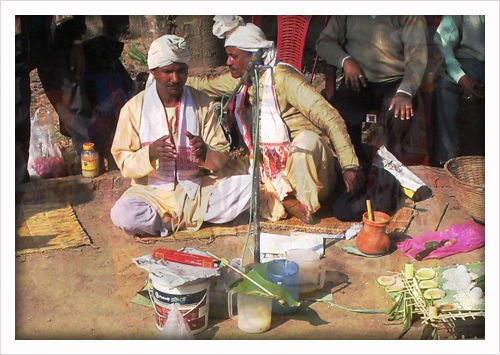
People offering prayers to their ancestors on the day of Me-Dum-Me-Phi
The essence of this festival is that the ancestors or the dead ones are worshipped by the family members so that the deceased is elevated to the position of ‘Phi’ or God. Even though Me-Dam-Me-Phi is celebrated throughout Assam, celebrations in the districts of Sivasagar, Dibrugarh and Lakhimpur are popular owing to the higher Tai Ahoms concentration in these areas. At present, the Ahom people observe Me-Dum-Me-Phi on the 31st of January each year and the same has been declared as a public holiday by the Government of Assam recognizing the importance of the day.
Majuli Festival
Majuli is the world’s largest river island. Celebrated on the banks of river Luit, the Majuli festival is always held during the winter season, in the month of November. The festival lasts for a total of 4 days showcasing a number of ethnic groups with their cultural performances. Artists and artisans from all over the state also come to exhibit their handmade products including traditional handicrafts and garments, locally made cane and bamboo products, and so on. Food fests are also organized at the festival and there is a rich display of the local delicacies of the state in general and of the tribes of Majuli in particular.
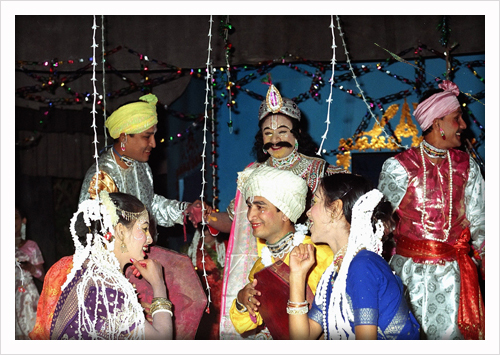
Glimpse of Majuli Raas Rila
The Majuli Festival is a major tourist attraction and lets the visitors have a glimpse of the culture and traditions of the island. The location is extremely scenic and serves as a perfect venue for the festival
Dehing Patkai Festival
The Dehing Patkai Festival organized at Lekhapani, in the Tinsukia district of Assam, is a stimulating blend of tribal fairs, tea heritage tours, golfing, adventure sports, and wildlife pleasure trip. The Festival aiming at boosting Tourism in the State is celebrated every year in the month of January and named after the lofty Patkai range and the playful Dehing River. This is an annual festival which lasts for three days.
The Dehing Patkai festival was initiated by the Assam Government in 2002 to promote the diverse culture of Assam. The chief guest of the first session of the festival was the then President of India Dr. APJ Abdul Kalam. Visitors can take an elephant rides and enjoy the scene beauty of the region. Trips to the tea gardens and the Digboi oil field are also arranged for the guests. Another interesting fact about the Dehing Patkai Festival is that it offers a trip to the 2nd World War cemeteries which speaks of history of the past. The festival also arranges for a trip to the Stilwell Road, which was once the passage to the golden land of Myanmar.
There are arrangements for Food Festival, Craft Fair, and Cultural Functions for the visitors. The visitors can take pleasure in a wide range of adventure sports on the dotted islands and the banks of the Brahmaputra River which include angling, kayaking and parasailing. This festival helps the villagers to endorse their artisanship to the tourists.
Kaziranga Elephant Festival
The Kaziranga Elephant Festival is a yearly elephant festival held in the Kaziranga National Park of Assam for the conservation and protection of Asiatic elephants. To spread more awareness about the need to preserve the elephants and save them from heading to extinction, the Kaziranga Elephant Festival is held. It is organized each year in February. This is a joint initiative of Tourism Department and Forest Department of the Government of Assam. The week long Elephant festival is being held at Kaziranga National Park since 2003..
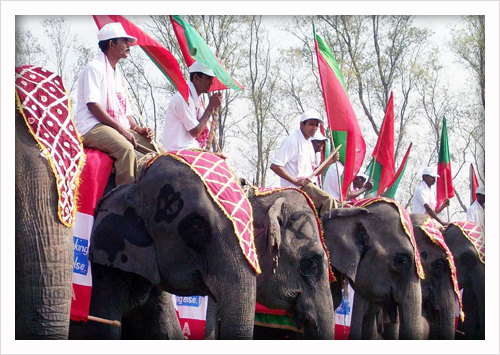
Elephants lined up for the Parade during the Kaziranga Elephant Festival
During the festival days, the park has an enthusiastic ambiance. Plenty of domesticated elephants are adorned extensively with attires, paints and they are paraded. There are events like elephant races, dance and games that viewers can enjoy. Apart from them, a number of regional artists displaying folk traditions also participate in the cultural events. Tourists throng the park to witness the events.
Ali Ai Ligang Festival
The Ali-Ai-Ligang Festival is celebrated by the Mishing tribe every year with much enthusiasm as it marks the onset of New Year for the tribe. The word ‘Ali’ denotes root, ‘Ai’ stands for fruit and ‘Ligang’ means sowing. So, the festival name basically denotes harvest and this is the reason why, the sowing in of paddy is started on this day ritually. Dresses in traditional attires, the Mishing people pay respect to their ancient God ‘Donyi-Polo’ for prosperity and harvest by offered eggs and fish during this festival.
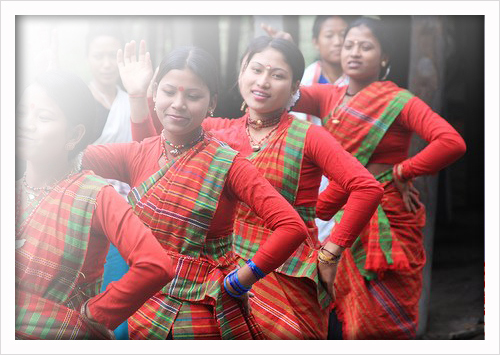
A group of dancers participating in the Community Programme
The Ali Ai Ligang Festival in Assam is celebrated during the spring season. It is held every year on the first Wednesday of the month of ‘Ginmur Polo’ or February-March. The festival continues for 5 days.
The festival is marked by sowing of paddy seeds. After this part of ceremony, young girls and boys of the tribe take part in ‘Gumrag’ dance. After the dancing part gets over, a grand community feast is held by the participants. The food includes treats like ‘Poro Aapong’ or rice beer, dried fish and pork. ‘Purang Apin’ (packed boiled rice) is specially prepared by the Misings only for the festival. During this festival, certain taboos are purely observed with respect to cutting trees, ploughing, fishing, burning jungles etc as per ancient rituals.
Junbeel Mela
Junbeel Mela is held every year around mid-January, usually during the weekend of the Assamese harvest festival, Magh Bihu in Dayang Belguri in Morigaon district of Assam. People barter goods, socialize for a few days, and then go back to their villages. No currency is used. Junbeel mela is perhaps the only occasion that brings the barter system alive in India today.

Community fishing during the Junbeel Mela
Literally speaking, Junbeel Mela means the ‘fair of the moon lake’. Indeed, the fair is held beside a naturally picturesque lake that is crescent-shaped. The fair ground is an open area slightly bigger than a football field and often community fishing is done in the Lake. Junbeel Mela is organized by the Tiwa community, with participants from the Tiwa, Karbi, Khasi and Jaintia communities, from the interiors of the state’s Morigaon and Karbi Anglong districts, as well as some border villages of Meghalaya.
The fair starts with worshiping the Fire where everyone participates and prays for world peace and harmony. It is then followed by a community feast, organised by the present Gobha Raja, the King of the Tiwa Lalung tribe. He takes part in the festival and also collects taxes from his subjects. The tax is, in fact, used to carry forward the tradition and hold the festival every year. The fair ends on the third day with an address by the King to his subjects and a cultural get-together, where diverse aspects of different tribes are presented, including traditional songs and dances.
The market offers fresh ginger, turmeric, arum, sesame, wild potatoes, chillies, herbs, other vegetables and fruits, rice cakes made by the tribals, dried fish, fresh fish, poultry, different types of aromatic rice, cotton, lac, traditional costumes, cane and bamboo products, wooden furniture, handicrafts and daily-use articles. The atmosphere is more of fun and merry than serious business.
Rongker & Chomangkan Festival
Rongker and Chomangkan are the two most important festivals of the Karbis, an indigenous tribe of Karbi Anglong in Assam. Rongker is basically a springtime festival and is performed at the beginning of the New Year. Prayers are offered to different Gods and Goddesses for the well being of the entire village, by the elderly male folk so that people could be free from diseases, natural calamities for the entire year. They pray for a good harvest too. The women are not allowed to enter the worship arena.
Chomangkan festival is devoted to dead people, it actually is a death ceremony performed by the Karbis who organize the funeral. This ceremony is performed at a later date so that the mortals gain endless peace. The Chomangkan ceremony lasts for nonstop four days and four nights and is a mandatory ceremony for every person in Karbi community. Chomangkan festival is performed for peace of harmony of the spirits.
Assam Tea Festival
The Assam Tea Festival is held in the district of Jorhat in Assam. Jorhat is well-known for its extensive tea gardens, the world famous Tocklai Tea Research Institute and is thus the nerve centre of the tea industry.
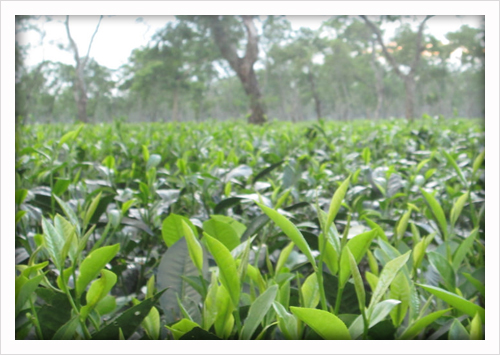
Luscious green tea gardens of Assam
The Assam Tea Festival is organised by Assam Tourism, and the events during the festival include tea tours around the estates, playing golf at the ‘Jorhat Gymkhana’, which is the world’s third oldest golf-club that is still in use, safaris into the jungles of the state, enjoying the local delicacies prepared by the natives, shopping and several cultural programs like tribal songs and folk dances. The festival is held every year during the winter season, from November to January. The whole state celebrates the prosperity of tea and also takes measures to protect and improve the production of the same. The visitors are offered with various flavours of tea. Conferences are also organized to discuss different issues in tea industry. An arrangement for visiting the Guwahati Tea Auction Centre, the biggest tea auction center in the country is one of the main attractions of the festival.
Raas Lila Festival
Raas Lila is a century long tradition in Majuli where a Bhaona or traditional dance dramas that depict tales from Hindu mythology are enacted by the devouts to pay their obeisance to Lord Krishna. During the Raas festival, Majuli becomes a place for pilgrimage. For the believers, the island becomes the abode of the Lord Krishna and other divinely figures during this four-day festival starting from the Raas Purnima day.
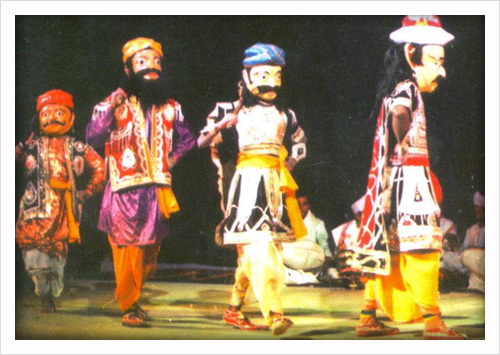
A group performing Raas Lila in Majuli
The Raas Lila is an annual festival being performed on the full moon day (Purnima) in the months of October-November (Kati- Aghun) during the autumn season though the exact date changes every year. During Raas Mahotsava, several thousand devotees visit the holy temples every year. The Raas Mahotsav of Majuli, Nalbari and of Howly deserves a special mention in this regard.
Karam Puja
Karam Puja is the most important agricultural festival of tea tribe communities of Assam. This is celebrated usually on Bhado Ekadashi, on the eleventh day of the bright full moon (Purnima) of the month of Bhado (August–September). The Karam tree, scientifically named Nauclea Parvifolia is the center of the proceedings of the festival.
During the auspicious day, people go to the jungle accompanied by a group of drummers singing and dancing merrily. They then cut one or more branches of the Karam tree. The branches are usually carried by unmarried, young girls who sing in praise of the deity. Then the branches are brought to the village and planted in the center of the ground which is plastered with cow-dung and decorated with flowers.

People singing and dancing around the Karam tree
People gather around the Karam tree and sing in praise of the deity. A tribal priest called ‘Jhankar’ or ‘Dehuri’ offers germinated grains and liquor known as ‘Haria’ to the deity. A fowl is also killed and the blood is offered to the branch. The priest recites a legend to the villagers about the evolution of Karam Puja. Women dance to the beat of drums, sing folk songs and rejoice. This is how the famous traditional dance forms of the Adivasis ‘jhumur’originated. The puja is followed by a community feast and the drinking of ‘Haria’. The next day the Karam tree is sprinkled with curd and immersed in the river bed.
There are many legends behind the initiation of Karam Puja although the real history of the festival is hardly known. For the people of Assam, the tea tribe community, Karam is the Goddess of creation. The Puja is performed by women for a better conjugal life. She is considered the Goddess of wealth and children.
Baishagu Festival
The Baishagu festival is celebrated with zeal and excitement by the Boro Kacharis tribe of Assam. This festival is celebrated in the month of April (the month of Baishak according to Assamese calendar) to welcome the New Year.
The first day of the Baishagu Festival begins with the worship of the cow. The following day the young people in each family show their gratitude to their parents and other elder members of the family. Lord Shiva or Bathou is worshipped on this day by offering chicken and rice beer etc. All young and old join together and rejoice the Baishagu. Many traditional musical instruments are played during the dance festival and are known as Kham, a drum, Jotha, a Manjari, Khawbang, the Taal, Gogona, the mouth-organ, and Siphung, the flute etc. The festival is often ended by offering community prayer at a specified place called, Garjasal.
Doul Utsav
The Doul Utsav also known as the ‘Deul’ in the local dialect is vibrantly celebrated by the people of Assam, especially in Barpeta. Doul Utsav also called ‘Holi’ or ‘Rang’is the festival of colour and happiness. The radiance of the Barpeta Satra, one of the most revered Vaishnavite centres of Assam truly represents a unique ambience during the Doul Utsav celebrated with zeal during the spring. Barpeta is known to celebrate the festival of colours in an entirely unique and grand style and thus many people from other parts of India, world and Assam itself travel to Barpeta to witness the Doul Utsav.

People gather for a glimpse of Lord Sri Krishna idol
Doul festival is celebrated for three to five days. In the month of Chot, Doul is celebrated for three days, which is called ‘Burha Doul’ and the Doul that is observed for four to five days, in the month of Phalgun is called ‘Deka Deul’. According to the tradition the four days Doul is held in the month of ‘Phagun Purnima’ (Full moon) and three days Doul is held in the month of ‘Chot Purnima’ (Full moon) as per the Hindu lunar calendar.
Holi geets or songs are a unique literary and musical contribution of the cultural heritage of Barpeta Doul Utsav. Bamboo crashing is also one of the most interesting parts of the last day of Doul Utsav. The town is tinted in Pink hues of colour on the last day on the Doul Utsav which is a spectacular sight in itself. People from different parts of the country and foreign tourists visit Barpeta during this festival to witness the zeal and seek the blessings of Lord Krishna.
Ambubashi Mela
The temple is one of 51 Shaktipeeths or seat of Shakti followers, each representing a body part of the Sati, Lord Shiva’s companion. The temple’s sanctum sanctorum houses the yoni — female genital — symbolised by a rock. Ambubashi Mela witnesses thousands of tantriks and sadhus in attendance from across the world, displaying their psychic powers making an extraordinary spectacle.

Ambubashi Mela at Maa Kamakhaya Temple
It is believed that the Goddess goes through her menstrual cycle every year in the month of June. All the temples in Assam including the Kamakhya Temple are closed during those days and no religious activities are performed. After three days, the Goddess is bathed and other rituals are performed. On the fourth day, the doors of the temple are reopened and prasad in the form of ‘Angodak’ and ‘Angabastra’ is distributed. ‘Angodak’ means the fluid part of the body which is basically water from the spring. While the ‘Angabastra’ also called as ‘Rakta Bastra’ which is cloth soaked in the menses of the Goddess.
The Ambubashi Mela is celebrated every year during the monsoon season, which happens to fall in around the middle of the month of June. Thus, every year during the time of Ambubashi a large number of devotees gather here to perform religious rituals.
Bare Saharia Bhaona
The Bare Saharia Bhaona is a 200-year-old drama festival held every 5–6 years at Jamugurihat, a small town in Sonitpur District, Assam. The name ‘Bare Saharia Bhaona’ consists of ‘Bare’ (Assamese word) which means ‘too many’ and ‘Saharia’ which means ‘People’. Thus the Bare Saharia Bhaona consist a festival or a program of Bhaona, where too many people come or gather to enjoy the Bhaona show. The festival was first held in 1797-98. The Bhaona begins with Gayan Bora and sounds of Doba, Kanh, Bhortal and Khol. Bhaona is a traditional drama festival of Neo-Vaishnavite culture of Assam, which was founded by the great Assamese saint Mahapusura Srimanta Sankardeva. To spread Neo-Vaishnavism among the people of the state, the saint invented this unique form of drama, through which he tried to promote this religious belief among the people of the state.